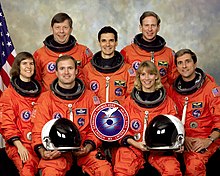STS-83

Columbia returns to the Kennedy Space Center following a fuel cell problem which caused its mission to be aborted after four days
|
|
| Mission type | Microgravity research |
|---|---|
| Operator | NASA |
| COSPAR ID | 1997-013A |
| SATCAT no. | 24755 |
| Mission duration | 3 days, 23 hours, 13 minutes, 38 seconds (Planned for 15 days and 16 hours) |
| Distance travelled | 2,400,000 kilometres (1,500,000 mi) |
| Spacecraft properties | |
| Spacecraft | Space Shuttle Columbia |
| Launch mass | 117,546 kilograms (259,144 lb) |
| Landing mass | 106,724 kilograms (235,286 lb) |
| Payload mass | 11,377 kilograms (25,082 lb) |
| Crew | |
| Crew size | 7 |
| Members |
James D. Halsell Susan L. Still Janice E. Voss Michael L. Gernhardt Donald A. Thomas Roger Crouch Greg Linteris |
| Start of mission | |
| Launch date | 4 April 1997, 19:20:32.074 UTC |
| Launch site | Kennedy LC-39A |
| End of mission | |
| Landing date | 8 April 1997, 18:33 UTC |
| Landing site | Kennedy SLF Runway 33 |
| Orbital parameters | |
| Reference system | Geocentric |
| Regime | Low Earth |
| Perigee | 298 kilometres (185 mi) |
| Apogee | 302 kilometres (188 mi) |
| Inclination | 28.45 degrees |
| Period | 90.5 min |
 Left to right - Front row: Voss, Halsell, Still, Thomas; Back row: Crouch, Linteris, Gernhardt |
|
STS-83 was a mission of the United States Space Shuttle Columbia.
This mission was originally launched on 4 April 1997, and was intended to be on orbit for 15 days, 16 hours. The mission was cut short due to a problem with Fuel Cell #2 and it landed on 8 April, after 3 days 23 hours. NASA decided to fly the mission again as STS-94, which launched 1 July 1997.
The primary payload on STS-83 was the Microgravity Science Laboratory (MSL). MSL was a collection of microgravity experiments housed inside a European Spacelab Long Module (LM). It built on the cooperative and scientific foundation of the International Microgravity Laboratory missions (IML-1 on STS-42 and IML-2 on STS-65), the United States Microgravity Laboratory missions (USML-1 on STS-50 and USML-2 on STS-73), the Japanese Spacelab mission (Spacelab-J on STS-47), the Spacelab Life and Microgravity Science Mission (LMS on STS-78) and the German Spacelab missions (D-1 on STS-61-A and D-2 on STS-55).
MSL featured 19 materials science investigations in four major facilities. These facilities were the Large Isothermal Furnace, the EXpedite the PRocessing of Experiments to the Space Station (EXPRESS) Rack, the Electromagnetic Containerless Processing Facility (TEMPUS) and the Coarsening in Solid–Liquid Mixtures (CSLM) facility, the Droplet Combustion Experiment (DCE) and the Combustion Module-1 Facility. Additional technology experiments were to be performed in the Middeck Glovebox (MGBX) developed by the Marshall Space Flight Center (MSFC) and the High-Packed Digital Television (HI-PAC DTV) system was used to provide multi-channel real-time analog science video.
The Large Isothermal Furnace was developed by the Japanese Space Agency (NASDA) for the STS-47 Spacelab-J mission and was also flown on STS-65 IML-2 mission. It housed the measurement of diffusion coefficient by shear cell method experiment, the diffusion of liquid metals and alloys experiment, the diffusion in liquid led-tin-telluride experiment, the impurity diffusion in ionic melts experiment, the liquid phase sintering II experiment (LIF), and the diffusion processes in molten semiconductors experiment (DPIMS).
...
Wikipedia

